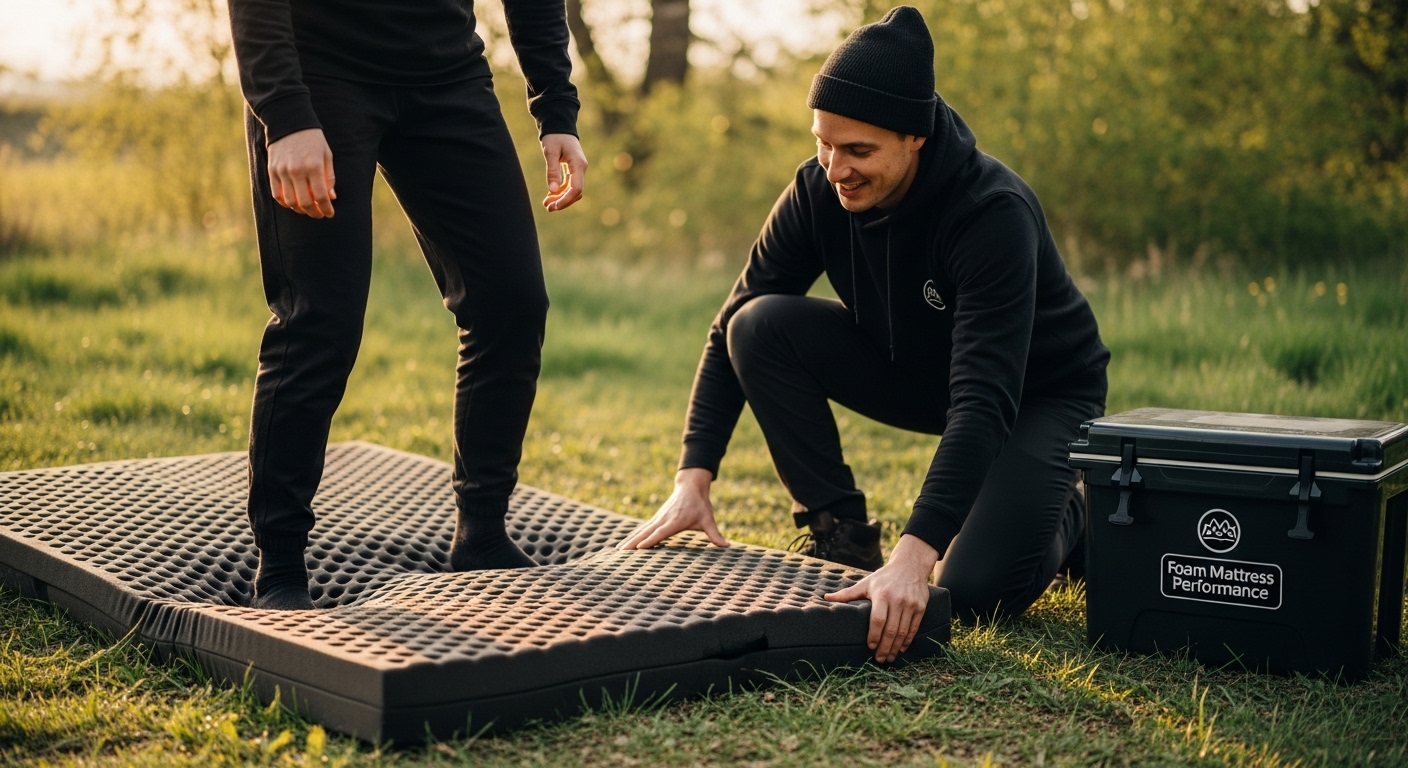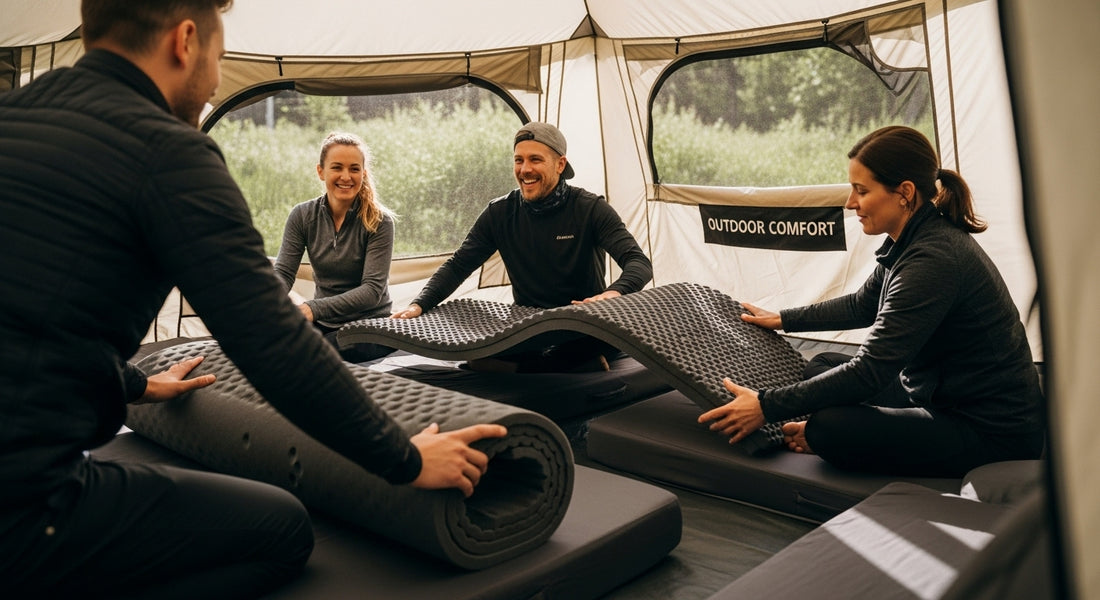Foam mattresses have become the go-to for campers and adventurers who want a good night’s sleep even in the wild. Most people assume comfort is their only selling point, but surprise. The real advantage lies in their adaptability and engineering. Some outdoor foam mattresses are dense enough to offer support at up to 5 pounds per cubic foot, while still staying light and compact for travel. That kind of performance can completely change the way you rest outdoors.
Table of Contents
- What Is A Foam Mattress And How Does It Work?
- Why Foam Mattress Performance Matters For Your Comfort
- Key Features That Influence Foam Mattress Performance
- Types Of Foam Mattresses And Their Practical Applications
- How Materials Affect Foam Mattress Performance In The Outdoors
Quick Summary
| Takeaway | Explanation |
|---|---|
| Foam mattresses adapt to body contours. | The viscoelastic properties of memory foam create a supportive and comfortable sleep surface that molds to individual shapes. |
| Density enhances mattress durability and support. | Higher density foam (3-5 PCF) provides better pressure relief and resilience for outdoor sleeping needs. |
| Temperature regulation is crucial for comfort outdoors. | Advanced foam technologies manage heat transfer and moisture, ensuring comfort in varying outdoor conditions. |
| Material choice affects overall mattress performance. | Understanding foam types, like closed-cell and open-cell, helps select the right mattress for specific adventure scenarios. |
| Quality sleep impacts physical recovery during adventures. | A high-performance foam mattress contributes to better sleep quality, aiding recovery and enhancing overall outdoor experiences. |
What is a Foam Mattress and How Does It Work?
Foam mattresses represent an innovative sleep technology designed to provide unparalleled comfort and support across various environments. These specialized mattresses utilize advanced material engineering to create a responsive sleeping surface that adapts to body contours and temperature. Learn more about outdoor memory foam applications to understand their versatility beyond traditional bedroom settings.
The Science Behind Foam Mattress Construction
At its core, a foam mattress is constructed from polyurethane materials engineered to offer unique performance characteristics. The fundamental composition involves multiple layers of synthetic foam with varying densities and properties. According to clinical research from medical materials engineering, these foam grades are evaluated through complex metrics like:
- Resiliency: How quickly the material returns to its original shape
- Density: Weight and compactness of the foam material
- Hardness: Resistance to compression and pressure
- Indentation force: Measurement of material’s load-bearing capabilities
Viscoelastic Properties and Body Adaptation
Viscoelastic foam, commonly known as memory foam, represents a sophisticated material that transforms the sleeping experience. Initially developed for medical applications, this foam uniquely responds to body heat and weight, creating a “cradling” effect that contours precisely to an individual’s physical shape. When pressure is applied, the foam molecules temporarily rearrange, distributing weight evenly and reducing pressure points.
This adaptive technology means that whether you are camping in a forest, resting in a tent, or setting up a temporary sleeping area, a foam mattress will provide consistent support and comfort. The material’s ability to respond to body temperature ensures that sleepers remain comfortable across different environmental conditions, making it an exceptional choice for outdoor enthusiasts seeking reliable rest.
Why Foam Mattress Performance Matters for Your Comfort
Outdoor enthusiasts understand that quality sleep can make or break an adventure. Foam mattress performance transcends mere comfort—it directly impacts physical recovery, energy levels, and overall outdoor experience. Check out our camp bedding organization guide to maximize your sleeping setup’s potential.
Physical Recovery and Sleep Quality
According to research from the Sleep Foundation, mattress performance significantly influences sleep quality and musculoskeletal health. For outdoor enthusiasts, this means a high-performance foam mattress can help mitigate physical strain from hiking, climbing, or extended travel. Key performance indicators include:
- Pressure point reduction
- Spinal alignment support
- Weight distribution capabilities
- Temperature regulation
Adapting to Diverse Outdoor Environments
Foam mattress performance becomes critically important when transitioning between varied terrain and climate conditions. A superior foam mattress must demonstrate remarkable adaptability—maintaining structural integrity and comfort whether you are camping in a humid forest, a desert landscape, or a high-altitude mountain environment. The mattress needs to resist temperature fluctuations, provide consistent support, and protect against moisture and uneven ground surfaces.
The right foam mattress transforms your outdoor sleeping experience from a necessity into a rejuvenating opportunity.
Its performance directly correlates with your ability to recover, rest, and prepare for the next day’s adventures, making it an essential investment for any serious outdoor enthusiast.
Key Features That Influence Foam Mattress Performance
Understanding the nuanced characteristics of foam mattresses is crucial for outdoor enthusiasts seeking optimal comfort and performance. These technical details determine how well a mattress will serve you during camping, hiking, and other adventure scenarios. Learn more about camping comfort strategies to complement your mattress selection.
Density and Material Composition
Foam mattress performance begins with its fundamental structural characteristics. According to research from Applied Ergonomics, the hardness and elasticity of mattress materials directly impact comfort and support. Critical aspects of density include:
![]()
- Measured in pounds per cubic foot (PCF)
- Higher density indicates more durable and supportive material
- Ranges typically between 3-5 PCF for outdoor mattresses
- Correlates with weight distribution and pressure relief capabilities
Thermal Regulation and Environmental Adaptability
Outdoor environments demand mattresses that can quickly adjust to changing temperatures and conditions. Advanced foam technologies incorporate specialized materials that manage heat transfer and moisture. This means your mattress can provide consistent comfort whether you are experiencing cold mountain nights or humid forest environments.
The ideal foam mattress for outdoor use must balance multiple performance factors. It should be lightweight enough for easy transport, dense enough to provide robust support, and flexible enough to conform to various sleeping surfaces. Temperature-responsive foams that can rapidly adjust to body heat and ambient conditions represent the cutting edge of mattress engineering, ensuring that outdoor enthusiasts can rest comfortably regardless of their environment.
Types of Foam Mattresses and Their Practical Applications
The world of foam mattresses is diverse, with each type offering unique characteristics tailored to specific outdoor and sleeping requirements. Understanding these variations helps outdoor enthusiasts select the most appropriate mattress for their adventures. Explore our comprehensive camping comfort guide to complement your mattress selection process.
Memory Foam and Viscoelastic Variants
According to the Better Sleep Council, memory foam represents a sophisticated category of mattress materials designed for exceptional body contouring and pressure relief. For outdoor applications, these mattresses demonstrate remarkable adaptability:
- Slow-response memory foam for deep pressure absorption
- Quick-response memory foam for faster recovery and movement
- Temperature-sensitive variants that adjust to environmental conditions
- Gel-infused memory foam for enhanced cooling properties
Polyurethane and Specialized Outdoor Foam Types
Polyurethane foam serves as a fundamental material in outdoor mattress construction, offering versatility and performance across different environments. Outdoor-specific foam mattresses are engineered to address unique challenges such as weight, compactness, and durability. These mattresses come in various configurations:
Closed-cell foam mattresses provide exceptional moisture resistance and insulation, making them ideal for challenging outdoor conditions. Open-cell foam designs offer superior breathability and lightweight characteristics, perfect for backpackers and minimalist campers seeking compact sleeping solutions.
The selection of a foam mattress ultimately depends on balancing factors like weight, packability, insulation, and comfort.
To help readers quickly compare foam mattress types for outdoor use, the following table outlines key characteristics, advantages, and best-use scenarios for each type described in the article.
| Foam Mattress Type | Key Characteristics | Advantages | Best Outdoor Use |
|---|---|---|---|
| Memory Foam | Viscoelastic, body contouring, slow/quick response | Excellent pressure relief, adapts to temperature | Car camping, base camps, colder climates |
| Gel-Infused Memory Foam | Memory foam with added cooling gel | Enhanced cooling, minimizes heat buildup | Warm climates and summer camping |
| Closed-Cell Foam | Dense structure, moisture-resistant | Superior insulation, durable, easy to clean | Wet conditions, lightweight backpacking |
| Open-Cell Foam | Lightweight, breathable, less dense | Improved airflow, compact, lightweight | Minimalist camping, backpacking |
| Polyurethane Outdoor Foam | Custom formulations for durability/weight | Versatile, balances comfort and portability | General outdoor use, variable climates |
 Each type offers distinct advantages, allowing outdoor enthusiasts to choose a mattress that precisely matches their specific adventure requirements and personal preferences.
Each type offers distinct advantages, allowing outdoor enthusiasts to choose a mattress that precisely matches their specific adventure requirements and personal preferences.
How Materials Affect Foam Mattress Performance in the Outdoors
The intricate relationship between mattress materials and outdoor performance determines the quality of rest adventurers experience. Understanding these complex interactions helps select the most suitable sleeping solution for various environmental challenges. Discover more about outdoor mattress selection to enhance your outdoor sleeping experience.
Thermal Conductivity and Insulation Properties
According to research from Sleep Foundation, mattress materials play a critical role in managing body temperature and providing comfort. Different foam compositions demonstrate unique thermal characteristics:
- Open-cell foam allows better air circulation
- Closed-cell foam provides superior insulation
- Gel-infused materials enhance heat dissipation
- Polyurethane variants offer temperature-neutral performance
Moisture Management and Material Resilience
Outdoor environments demand materials that can withstand humidity, temperature fluctuations, and physical stress. Advanced foam technologies incorporate specialized molecular structures that resist moisture absorption and maintain structural integrity. Polyurethane foams, particularly those with high-density formulations, demonstrate remarkable durability and adaptability across diverse outdoor conditions.
The most effective outdoor mattresses blend multiple material technologies, creating a sophisticated sleep surface that responds dynamically to environmental challenges. By understanding how different foam compositions interact with temperature, moisture, and physical pressure, outdoor enthusiasts can select mattresses that provide consistent comfort and support in unpredictable environments.
Upgrade Outdoor Sleep With Hazli’s Advanced Foam Mattresses
After reading about foam mattress performance and the need for real comfort during outdoor adventures, are you tired of restless nights on uneven or unsupportive surfaces? The article highlights how pressure point relief, thermal regulation, and material durability can make or break your recovery after a long day outdoors. You deserve a solution designed specifically to address these pains with memory foam engineered for adventure.

Experience the difference with a high-quality outdoor memory foam mattress from Hazli Collection. Our products deliver adaptive support and resilience for any camping condition, giving you better sleep and energy for tomorrow’s adventure. Visit Hazli Collection’s main site now to find your perfect mattress and outdoor gear—because the right choice today leads to better rest tonight. Don’t let your next adventure be held back by poor sleep. Shop now and invest in your comfort.
Frequently Asked Questions
What is a foam mattress?
A foam mattress is a specialized sleeping surface made from polyurethane materials designed to adapt to body contours and temperature, providing enhanced comfort and support for various environments.
How does memory foam work to improve sleep quality?
Memory foam, or viscoelastic foam, responds to body heat and weight, creating a cradling effect that evenly distributes pressure and reduces pressure points, ultimately enhancing sleep quality and physical recovery.
What are the key features to consider when choosing a foam mattress for outdoor use?
When selecting a foam mattress for outdoor activities, consider density, material composition, thermal regulation, moisture resistance, and adaptability to changing environmental conditions.
What types of foam mattresses are recommended for outdoor enthusiasts?
Memory foam, closed-cell foam, and specialized outdoor polyurethane variants are recommended. Memory foam provides body contouring, while closed-cell foam offers moisture resistance and insulation, making them suitable for various outdoor conditions.

